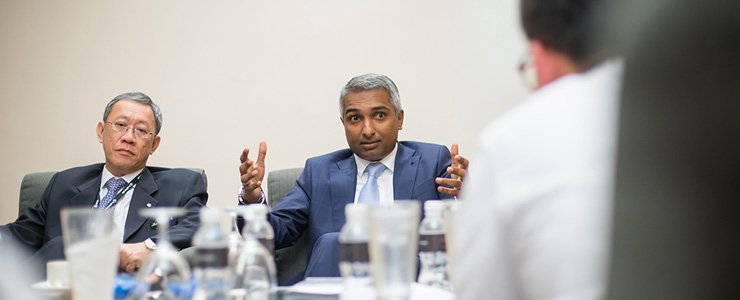Behind Lexus' new face and future directions
19 Jan 2016|8,584 views
Lexus has been on a roll ever since the introduction of its new face - the spindle grille - in 2012 and at the recent Singapore Motor Show 2016, where Lexus had its new range of eye-catching cars on display, we had an opportunity to get up close and personal with Giri Venkatesh (GV), General Manager, Brand Management, Lexus Asia Pacific, to find out more about the brand's success and its plans for the future.
SGCM: We are curious, Giri, what car do you drive on a daily basis?
GV: I'm actually allocated a Toyota Camry as a company car, but for sentimental reasons, because of my association with this particular car from the beginning, I drive a ninth generation Toyota Corolla. The first Corolla Altis.
SGCM: Last year, a video of the Lexus Hoverboard was released. While we understand it's as much a marketing campaign as it's a technical exercise, can we expect to see such electromagnetic technology making its way into Lexus cars? Basically, how relevant is that technology?
GV: Firstly, I think it is about making our brand different from what it used to be and what people were used to with Lexus. And I dare say, the results showed when we saw the global response, whether it was the customers or the media, everybody was just "Wow, did Lexus really make that?". I think this is in line with our philosophy and what our brand stands for, which is to push boundaries to something we've never done before.
As to whether it's going to be available in future technology or in our cars, obviously I can't divulge those kind of information, but all I can say is who knows and why not? From a personal point of view, this is what I told some friends, "This is what Lexus has done. If we can do this to a hoverboard, imagine what we can do to our cars." That's where I left it at.
SGCM: Do you think Lexus has been playing it safe for the past five years?
GV: No, I think for the past five years, the brand has grown by leaps and bounds. It started off when you look back at the 2012 Lexus GS. When we announced to the world the new face of what Lexus is - the spindle grille - that I think kickstarted a position of where we are today and it also gives a glimpse of what's to come in the future.
To add on, I'm sure you must have heard that the recently unveiled LC500 in Detroit was also awarded Best Production Car and Best Designed Interior and I think that is a statement of where we've come in the last five years so I don't think we’ve played it safe at all.
SGCM: Since Lexus is introducing turbocharging technology to its fleet - what are the reasons for the GS F as well as the LC500 sticking to a naturally aspirated (NA) 5.0-litre V8 engine? Are these the last of the NA lineage, or can we expect to continue seeing Lexus making such high-performance NA cars?
GV: Firstly, Lexus starts and ends with the customer. I think customers have given us the feedback that they want to continue seeing raw power that a naturally aspirated engine can provide.
And we're seeing that from the demand for the GS F that was launched globally just a couple of months ago, the waiting time in Japan for this car is already a year. I hope that it will be the same in Singapore, and if we can create such demand for such a beautiful car, I think it would be awesome. Going forward, the LC500 has given a hint that we're not stopping. We're going to continue and from a customer's point of view, the demand is there.
 |
SGCM: A lot of people are saying that Lexus is playing the catch-up game with the late foray of turbocharged engine market. What do you have to say about that?
GV: The turbo engine has actually been in development for the past 10 years. It's not something that was conceived just two years ago and if it was, then probably yes. But I think the important thing here was to find the product and the right time to introduce the technology and with the NX came the right product. As a matter of opinion on whether the time was too late or too early, I think it depends.
Why I say this is when you look at our results last year, the NX was our fastest growing product. Are we late in the game? I don't think so. If we were, then we wouldn't have grown that much.
SGCM: With the change that Lexus has been going through and with the introduction of turbocharged engines to the IS and the GS, is there a possiblity that you will alienate quite a fair bit of customers?
I think there are two aspects to that. The core Lexus customers, who have been with the brand since the beginning or have owned Lexus for 15 years or more, they are so used to what Lexus is. But at the same time, when we look at customer demand and where the market share is shifting towards, I think we needed to find the new niche.
The other aspect was the LF-NX concept, before the NX itself. That was really the game changer because people were like, "What?! This is a Lexus?". With this change, we've also brought a new type of customer. The fact is that we've now got younger customers, which we never saw in our showrooms before. That to me, is a good thing, because if we can get the younger customers today, hopefully we will be able to keep them tomorrow. We embrace change and we are slowly and surely finding that customers are also embracing the change that Lexus is bringing.

GV: I'm not an engineer and I can't give you the specific details of it but from my understanding, they can be tuned but it's also on finding the right balance and right now this is the balance we think is most suitable given the current situation.
SGCM: These days, the two big developments in the global automotive industry appear to be electrification and autonomous vehicles. What can you tell us about where Lexus stands on these two matters? Are there new developments in the pipeline?
GV: If you saw the concept - the LF-FC - that we showed in Tokyo last October, that perhaps kind of gives (I'm not saying it will) a glimpse of where we could go. I think fuel cells are going to be a big part of the future car industry. We've seen that, at least from the Toyota brand, in the Mirai, and going forward, I think we can also see that with Lexus, maybe. As for the other type, I think it will be very interesting to see how well more the likes of Tesla is. In my opinion, I think the jury is still out.
Lexus has been on a roll ever since the introduction of its new face - the spindle grille - in 2012 and at the recent Singapore Motor Show 2016, where Lexus had its new range of eye-catching cars on display, we had an opportunity to get up close and personal with Giri Venkatesh (GV), General Manager, Brand Management, Lexus Asia Pacific, to find out more about the brand's success and its plans for the future.
SGCM: We are curious, Giri,what car do you drive on a daily basis?
GV: I'm actually allocated a Toyota Camry as a company car, but for sentimental reasons, because of my association with this particular carfrom the beginning, I drive a ninth generation Toyota Corolla. The first Corolla Altis.
SGCM: Last year, a video of the Lexus Hoverboard was released. While we understand it's as much a marketing campaign as it's a technical exercise, can we expect to see such electromagnetic technology making its way into Lexus cars? Basically, how relevant is that technology?
GV: Firstly, I think it is about making our brand different from what it used to be and what people were used to with Lexus. And I dare say, the results showed when we saw the global response, whether it was the customers or the media, everybody was just "Wow, did Lexus really make that?". I think this is in line with our philosophy and what our brand stands for, which is to push boundaries to something we've never done before.
As to whether it's going to be available in future technology or in our cars, obviously I can't divulge those kind of information, but all I can say is who knows and why not? From a personal point of view, this is what I told some friends, "This is what Lexus has done. If we can do this to a hoverboard, imagine what we can do to our cars." That's where I left it at.
SGCM: Do you think Lexus has been playing it safe for the past five years?
GV: No, I think for the past five years, the brand has grown by leaps and bounds. It started off when you look back at the 2012 Lexus GS. When we announced to the world the new face of what Lexus is - the spindle grille - that I think kickstarted a position of where we are today and it also gives a glimpse of what's to come in the future.
To add on, I'm sure you must have heard that the recently unveiled LC500 in Detroit was also awarded Best Production Car and Best Designed Interior and I think that is a statement of where we've come in the last five years so I don't think we’ve played it safe at all.
SGCM: Since Lexus is introducing turbocharging technology to its fleet - what are the reasons for the GS F as well as the LC500 sticking to a naturally aspirated (NA) 5.0-litre V8 engine? Are these the last of the NA lineage, or can we expect to continue seeing Lexus making such high-performance NA cars?
GV: Firstly, Lexus starts and ends with the customer. I think customers have given us the feedback that they want to continue seeing raw power that a naturally aspirated engine can provide.
And we're seeing that from the demand for the GS F that was launched globally just a couple of months ago, the waiting time in Japan for this car is already a year. I hope that it will be the same in Singapore, and if we can create such demand for such a beautiful car, I think it would be awesome. Going forward, the LC500 has given a hint that we're not stopping. We're going to continue and from a customer's point of view, the demand is there.
SGCM: A lot of people are saying that Lexus is playing the catch-up game with the late foray of turbocharged engine market. What do you have to say about that?
GV: The turbo engine has actually been in development for the past 10 years. It's not something that was conceived just two years ago and if it was, then probably yes. But I think the important thing here was to find the product and the right time to introduce the technology and with the NX came the right product. As a matter of opinion on whether the time was too late or too early, I think it depends.
Why I say this is when you look at our results last year, the NX was our fastest growing product. Are we late in the game? I don't think so. If we were, then we wouldn't have grown that much.
SGCM: With the change that Lexus has been going through and with the introduction of turbocharged engines to the IS and the GS, is there a possiblity that you will alienate quite a fair bit of customers?
I think there are two aspects to that. The core Lexus customers, who have been with the brand since the beginning or have owned Lexus for 15 years or more, they are so used to what Lexus is. But at the same time, when we look at customer demand and where the market share is shifting towards, I think we needed to find the new niche.
The other aspect was the LF-NX concept, before the NX itself. That was really the game changer because people were like, "What?! This is a Lexus?". With this change, we've also brought a new type of customer. The fact is that we've now got younger customers, which we never saw in our showrooms before. That to me, is a good thing, because if we can get the younger customers today, hopefully we will be able to keep them tomorrow. We embrace change and we are slowly and surely finding that customers are also embracing the change that Lexus is bringing.

SGCM: We noticed the cars that will be using the 2.0-litre turbo engines have been named/referred to as the IS Turbo, GS Turbo, RX Turbo and so on. Does it mean that these models will only have one turbocharged petrol engine option and only one state of tune?
GV: I'm not an engineer and I can't give you the specific details of it but from my understanding, they can be tuned but it's also on finding the right balance and right now this is the balance we think is most suitable given the current situation.
SGCM: These days, the two big developments in the global automotive industry appear to be electrification and autonomous vehicles. What can you tell us about where Lexus stands on these two matters? Are there new developments in the pipeline?
GV: If you saw the concept - the LF-FC - that we showed in Tokyo last October, that perhaps kind of gives (I'm not saying it will) a glimpse of where we could go. I think fuel cells are going to be a big part of the future car industry. We've seen that, at least from the Toyota brand, in the Mirai, and going forward, I think we can also see that with Lexus, maybe. As for the other type, I think it will be very interesting to see how well more the likes of Tesla is. In my opinion, I think the jury is still out.
Thank You For Your Subscription.






























